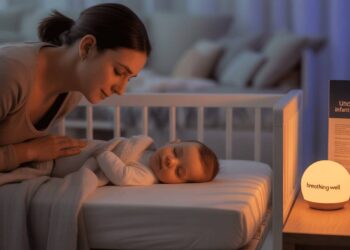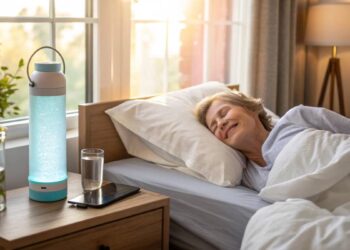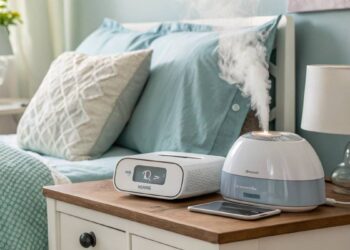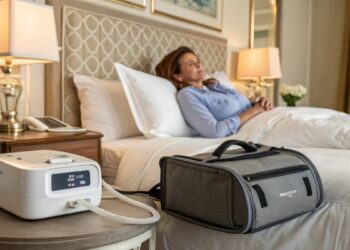Sleep apnea can silently disrupt your nights and drain your days, but understanding and addressing it is the first step toward reclaiming restful sleep and vibrant health. Whether you’re grappling with loud snoring or more severe breathing interruptions, knowing the ins and outs of sleep apnea and the tools available to manage it can make all the difference. This comprehensive guide delves into what sleep apnea is, the consequences of leaving it untreated, and how anti-snoring devices can enhance your sleep quality. Discover practical tips and explore top-rated CPAP humidifiers that turn restless nights into peaceful slumbers, ensuring every morning starts refreshed and energized.
Key Takeaways
- Understanding Sleep Apnea: Learn the differences between obstructive and central sleep apnea and their impacts on health.
- Consequences of Untreated Sleep Apnea: Recognize the severe health risks, including cardiovascular problems and impaired daily performance.
- Anti-Snoring Devices: Explore various gadgets designed to reduce snoring and improve sleep quality for both users and their partners.
- Choosing the Right Anti-Snoring Gadget: Consider factors like comfort, effectiveness, maintenance, and compatibility with other treatments.
- Lifestyle Changes: Implement practical lifestyle adjustments such as weight management, optimal sleep positions, and avoiding alcohol to enhance sleep quality and reduce apnea symptoms.
Understanding Sleep Apnea
What is Sleep Apnea?
Sleep apnea, a pretty common sleep wrecker, is all about those pesky breathing interruptions while you catch some z’s. Some folks might find their breathing getting shallow, or hitting pause altogether. The two usual suspects in this rodeo are:
- Obstructive Sleep Apnea (OSA): The top culprit, usually set off by a clog in the upper airway caused by too much weight or tonsils going all grandiose on you.
- Central Sleep Apnea: Less frequent and happens when the brain decides to hit snooze on sending breathing instructions.
“Sleep is the best meditation.” – Dalai Lama
For more deets on why this happens and how to spot it, are handy articles on the causes of sleep apnea and a breakdown of central vs obstructive sleep apnea.
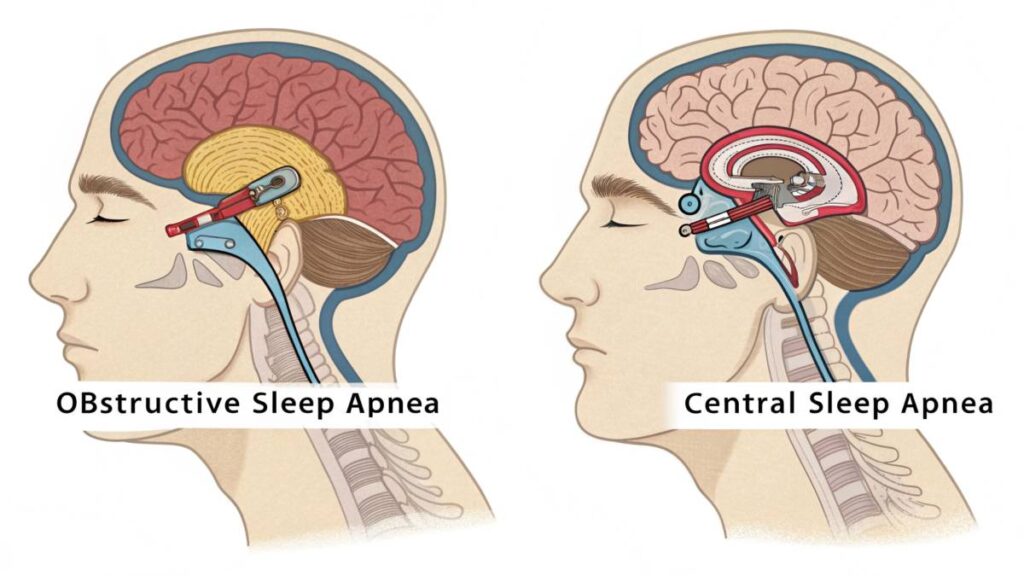
Consequences of Untreated Sleep Apnea
Ignoring sleep apnea ain’t just about missing a good night’s rest—it’s a shortcut to a bunch of other health issues. Here’s a look-see at what might come knocking at your door if you leave it be:
| Consequence | Description |
|---|---|
| Cardiovascular Problems | Pump issues, like high blood pressure, heart attacks, and strokes, are more likely with untreated apnea in the picture. OSA can ramp up the risk of heart troubles. |
| Daytime Fatigue | With all the nighttime tussles, you might start feeling like a zombie during the day, leaving you dragging through your to-do list. |
| Weight Gain | Sleep getting chopped up can mess with your appetite hormones, nudging you towards packing on extra pounds. Got more questions on this? Check out does weight loss help sleep apnea. |
| Mental Health Issues | The constant battle for air can mess with your mood highway, often paving it with anxiety or depression. Sleep stress is real! |
| Impaired Performance | When you’re drowsy, response times go out the window, not ideal if your job requires sharp reflexes, like if you’re a truck driver. |
There are also other issues, like metabolic hiccups and surgical road bumps. Parents, keep an eye out too—a similar bag of tricks can show up in kids. More info on this in pediatric sleep apnea symptoms.
Getting the hang of sleep apnea makes it clear why chasing after solutions, like hunting down the best anti-snoring devices, and tweaking some daily habits can be such a game-changer.
Identifying the Need for Anti-Snoring Devices
Snoring isn’t just about noise—it’s about sleep quality for everyone in the room. If you’ve been tossing and turning, wondering who actually needs a nap-time gadget, read on.
Who Gets the Most Out of Anti-Snoring Devices?
- Folks Carrying Extra Pounds: If you’ve got a few extra love handles, you might find your airway getting a bit squished, especially when you’re counting sheep. These devices can help you snooze without the background soundtrack.
- Anyone Over the Big 4-0: Age brings wisdom—and sometimes a rattling wake-up call. Folks past 40 might notice more nighttime noise. Consider anti-snoring devices your new comfy pillow.
- Bunkmates of Snore Monsters: There’s no need to sleep in earplugs anymore. Those sharing their bed with a snorer can finally hear the blissful silence once in a while with a little help from these gadgets.
- Pro Drivers on the Road: For those who need to keep their eyes open during the day because the Department of Transportation says so, getting good sleep is a must. Again, anti-snore helpers can be a real lifesaver—figuratively and literally.
- Not a Fan of CPAP Machines: Not everyone’s into the whole Darth Vader vibe that comes with CPAP. Snore-busting gear offers another route to nighttime peace without the mask.
- Parents with Sleepy Heads: Little ones who snore might be telling you they need some attention. Looking into snore prevention could be part of a bigger plan to make sure they’re sleeping soundly.
- Ladies After Menopause: Hormones can stir up some rough waters in the snoring sea. A nifty device might help calm those waves and let you drift off peacefully.
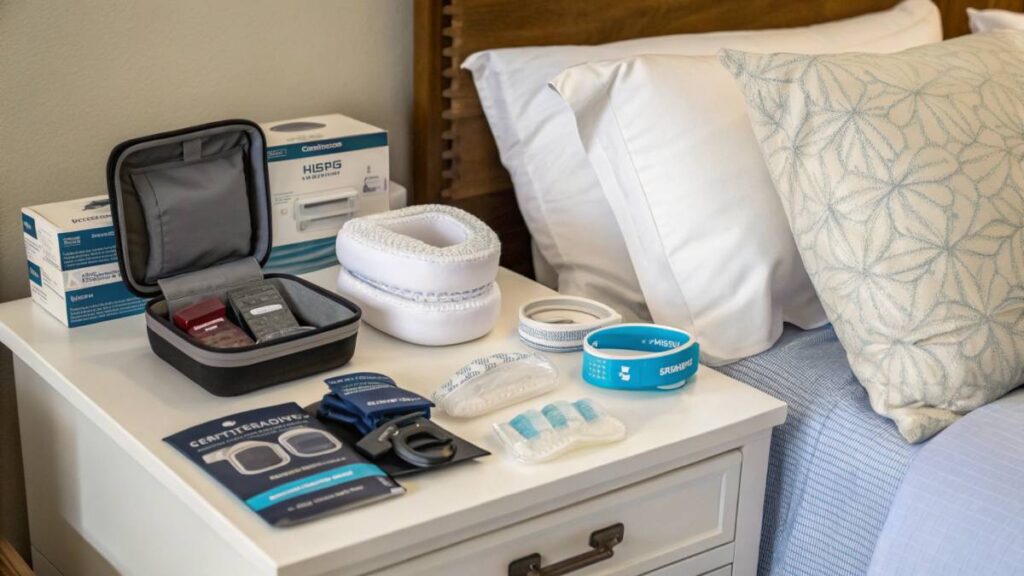
Hit Up a Doc Before Diving In
Before you throw a device in your shopping cart, chat with a doctor. They can help figure out if something more serious like sleep apnea is caught up in all that snoring. Knowing the warning signs helps figure out what to do next:
| Symptom/Condition | What’s Going On |
|---|---|
| Loud Snoring | You know who you are—partners have been talking. |
| Gasping or Choking | Your night might have some hidden surprises. |
| Too Tired During the Day | If coffee isn’t cutting it, your sleep might be trash. |
| Morning Headaches | Weirdly like a hangover without the fun from last night. |
| Trouble Focusing | Running on empty can mess with your daily grind. |
Check out more about what sleep apnea could mean by flipping through our articles on sleep apnea symptoms and what causes sleep apnea. A quick visit to the doc means getting advice made just for you, alongside exploring alternatives to CPAP, keeping your bedtime rolling smoothly.
Types of Anti-Snoring Gadgets
Snoring got you feeling like you’re sharing a bed with a chainsaw? Good news is, there’s a gadget for that! We’ve got a variety of snore-busting devices to fit your vibe. Let’s chat about nasal gadgets, mouth gadgets, chin straps, and some position tricksters.
Nasal Gadgets
These aim to open up your nose so air can whoosh in and out better.
- Nasal Strips: Stick these babies on your nose, and they pry your nostrils open like a car jack! Easier breathing spells less honking at night.
- Nasal Dilators: Slide these up your nostrils, and voila! Instant airflow highway.
| Device Type | Description | How it Works |
|---|---|---|
| Nasal Strips | Stick-on nose lifters | Okay to Awesome |
| Nasal Dilators | Nose wideners that fit inside | Meh to Okay |
Mouth Gadgets
Think of these as mouthguards that double as a snore extinguisher. They move your jaw and tongue forward to keep the snore tunnel clear.
- Custom-Made MADs: Like your bespoke tux, these are molded just for you. Great fit, bigger price though.
- OTC MADs: These are cheaper and can be shaped at home. They might not kiss your gums like a custom fit, but they get the job done.
| Device Type | Description | Snore Rating |
|---|---|---|
| Custom-Made MADs | Tailor-made for your grin | Through the Roof |
| OTC MADs | Budget-friendly and self-moldable | Okay to Awesome |
Chin Straps
Basically, a hug for your chin to shut your mouth during Z’s so you’re all nose when breathing.
Good deal if your snoring starts when you mouth breathe.
| Device Type | Description | Snore Rating |
|---|---|---|
| Chin Straps | Keeps jaws snug for nose action | Meh to Okay |
Positional Tricks
These dabble in a little sleep-time feng shui — they help you crash in ways that hush your snoring, especially sleeping sideways.
- Wearables: Like a teched-out fanny pack but for your sleep, they buzz or beep when you’re snoozing wrong.
- Special Pillows: Encourage side sleeping and slap you with discomfort if you roll over.
| Device Type | Description | Snore Rating |
|---|---|---|
| Wearables | Nudge wearer for positioning | Okay to Awesome |
| Special Pillows | For side snooze enthusiasts | Through the Roof |
Each gadget attacks snoring from a different angle. Now you’re ready to pick what’s best for your all-night harmony. Check out extra stuff like snore’s evil twin: sleep apnea or natural soothing tricks for apnea. Sweet dreams ahead!
Sure thing, let’s make this a lot less snooze-worthy.
Considerations for Picking an Anti-Snore Gadget
Picking out the right anti-snore thingy isn’t as easy as grabbing a snack from the pantry. You gotta think about a few things to make sure it helps your sleep and doesn’t end up chucked under the bed.
“The greatest wealth is health.” – Virgil
Comfort and Fit
If your anti-snore gizmo feels like a medieval torture device, it’s gonna end up against the wall. The thing’s gotta vibe with your jaw or nose, snug and irritation-free.
| Gadget Type | Fit Options |
|---|---|
| Nose Thingies | Assorted sizes, some with nifty adjustments |
| Mouthy Bits | Can get personal in a “custom-fit” way or try the DIY boil-n-bite thing |
| Chin Holders | Adjustable to stop it from strangling you in your sleep |
| Back Buddy Gadgets | Sized for all shapes when you gotta change how you sleep |
How Well It Works
Does it work or is it just another dust collector? Check reviews and science-y stuff to see if folks are snoring less and sleeping better.
| Gadget Type | How People Say It Works |
|---|---|
| Nose Thingies | Rocks for mild snore fits ‘cause of a stuffed nose |
| Mouthy Bits | Good for most snorers, especially if your mouth’s the troublemaker |
| Chin Holders | Handy if you snore more or less only when your gob’s hanging open |
| Back Buddy Gadgets | Pretty solid for those who snore when they’re on their back |
Keeping It Tidy
Don’t beat around the bush; keeping your gadget clean is just non-negotiable. Clean it like your nose depends on it–and it basically does in case of germs.
| Gadget Type | Upkeep |
|---|---|
| Nose Thingies | Rinse and dry the sucker every day |
| Mouthy Bits | Brush it daily; go deep every now and then |
| Chin Holders | Toss it in the wash often |
| Back Buddy Gadgets | Most are machine washable or can be wiped clean without drama |
Playing Nice with Other Treatments
If you’re also using other sleep aids, make sure your anti-snore helper isn’t riding solo; it should play nice in the therapy sandbox.
| Your Treatment | How They Get Along |
|---|---|
| CPAP Gadgets | Some can go together like PB&J; just check they don’t clash |
| Surgery Survivors | Ask your doc so you won’t end up in hot water |
| Lifestyle Tweaks | Make the gadget jive with changes in how you snooze or munch |
Finding your anti-snore savior takes some elbow grease in comfort, spin-in effectiveness, upkeep, and partnering with other tricks you’ve got up your sleeve. Dive into options, and match that thing to your quirks. For more snore-stopping secrets, peek at the sleep apnea symptoms section and other cool tips.
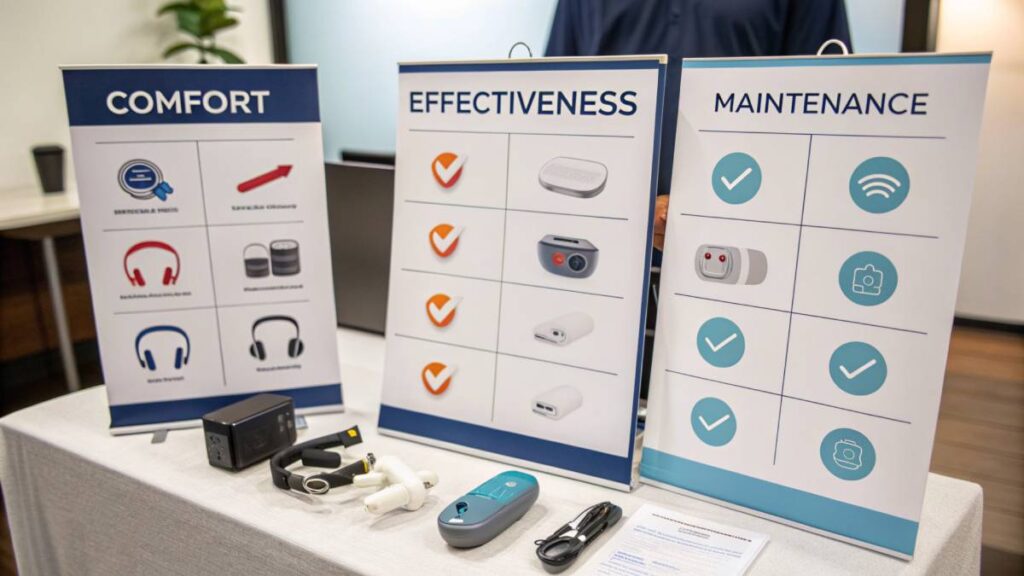
Hope the snooze-talk now has a bit more pep to it! 😴🔊
Lifestyle Changes and Additional Tips
Ready to tackle snoring and sleep apnea? Let’s get down to some practical advice that’ll have you sleeping like a baby.
Weight Management
Carrying extra pounds, especially around the neck, can put a chokehold on restful sleep. Dropping some weight not only lightens the load on your waistband but can also ease airway blockages that mess with your zzz’s.
| Weight Change | Impact on Your Zzz’s |
|---|---|
| 5-10% | Some peace at night |
| 10-20% | Snooze a lot better |
| 20+% | Say hello to peaceful slumber |
Curious how slimming down can help snoring and sleep apnea? Check out does weight loss help sleep apnea.
Sleep Position
How you sleep can make a world of difference. Catching those zzz’s lying flat on your back might be convenient, but for folks dealing with apnea, it often leads to blocked airways.
| Sleep Position | What to Do |
|---|---|
| On your back | Steer clear if you’ve got apnea |
| On your side | Keep airways happy and clear |
| On your tummy | It works, although it’s a bit old-school |
For tips on sleep setups that help, swing by best sleep position sleep apnea.
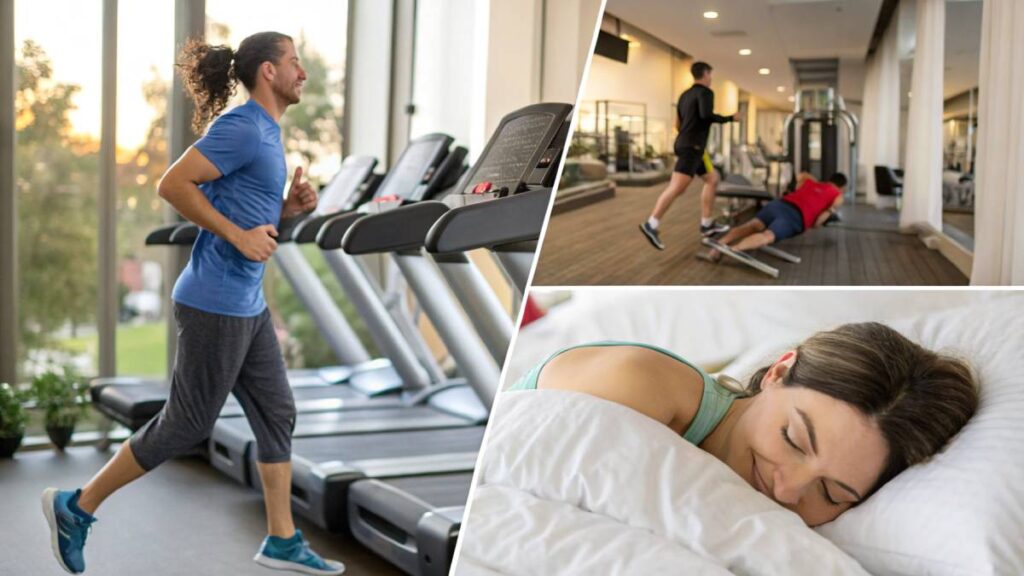
Avoiding Alcohol and Sedatives
Drinking and knocking back sedatives are like inviting the loud snooze symphony to your bedroom. They relax throat muscles, which can lead to blocked breathing paths. Skip ’em before bed for sound sleep.
| Substance | What It Does to Snooze Time |
|---|---|
| Alcohol | Adds fuel to sleep apnea fire |
| Sedatives | Cranks up airway blockages |
Wondering how to manage nighttime issues? Dive into sleep apnea symptoms.
Establishing a Sleep Routine
Keeping the same bedtime and wake-up times is like giving your body a mini-vacation. It helps set your internal clock so you can drift off and stay in dreamland more easily.
| Routine Stuff | Tips to Try |
|---|---|
| Sleep duration | Shoot for 7-9 glorious hours |
| Wind-down period | Start a chill-out ritual before bed |
| Sleep environment | Bedrooms should be dark, quiet, and as comfy as an old pair of slippers |
For more ways to master the art of sleeping better, dive into natural sleep apnea remedies.
Main Tips
- Comfort and Fit: Choose anti-snoring devices that fit well and feel comfortable to ensure consistent use.
- Effectiveness: Research and select devices proven to reduce or eliminate snoring based on reviews and clinical evidence.
- Regular Maintenance: Keep your devices clean and maintained to ensure hygiene and optimal performance.
- Lifestyle Adjustments: Incorporate healthy habits such as weight management, optimal sleep positions, and avoiding alcohol to complement device usage.
- Consult Healthcare Professionals: Always consult with a doctor before starting any new treatment to ensure it’s appropriate for your specific condition.
Final Thoughts
Sleep apnea is more than just a nighttime annoyance—it’s a serious health concern that warrants attention and effective management. By recognizing the signs and understanding the consequences of untreated sleep apnea, individuals can take proactive steps toward better sleep and improved health. Anti-snoring devices offer a practical alternative to traditional CPAP therapy, making it easier to achieve restful nights without the discomfort of continuous positive airway pressure machines. Coupled with top-rated CPAP humidifiers, these solutions provide a comprehensive approach to managing sleep apnea, enhancing not only sleep quality but also overall well-being. Embrace these strategies and resources to transform your sleep experience, ensuring that every night is a step toward a healthier, more energized you.
Conclusion
Addressing sleep apnea is crucial for maintaining overall health and ensuring restful, uninterrupted sleep. By understanding the types and consequences of sleep apnea, individuals can take proactive steps to mitigate its impact through effective treatments and lifestyle changes. Anti-snoring devices offer a versatile solution for those seeking alternatives to CPAP therapy, enhancing sleep quality and fostering better relationships. Coupled with top-rated CPAP humidifiers, these strategies create a comprehensive approach to managing sleep apnea, leading to healthier, more energized days. Embrace these insights and tools to transform your nightly rest and improve your quality of life.
FAQs
What is Sleep Apnea?
Sleep apnea is a common sleep disorder characterized by repeated interruptions in breathing during sleep, which can lead to poor sleep quality and various health issues.
What are the main types of Sleep Apnea?
There are three main types:
- Obstructive Sleep Apnea (OSA): Caused by a blockage in the upper airway.
- Central Sleep Apnea (CSA): Occurs when the brain fails to send proper signals to the muscles that control breathing.
- Complex Sleep Apnea Syndrome: A combination of both obstructive and central sleep apnea.
What are the consequences of untreated Sleep Apnea?
Untreated sleep apnea can lead to serious health problems, including high blood pressure, heart disease, stroke, daytime fatigue, weight gain, mental health issues, and impaired performance at work or while driving.
Who can benefit from anti-snoring devices?
Individuals who carry extra weight, are over 40, share their bed with a snorer, are professional drivers, dislike CPAP machines, parents with snoring children, and women after menopause can benefit significantly from anti-snoring devices.
What should I consider when choosing an anti-snoring gadget?
Consider factors such as comfort and fit, effectiveness, ease of maintenance, compatibility with other treatments, and specific features tailored to your snoring patterns and lifestyle.




